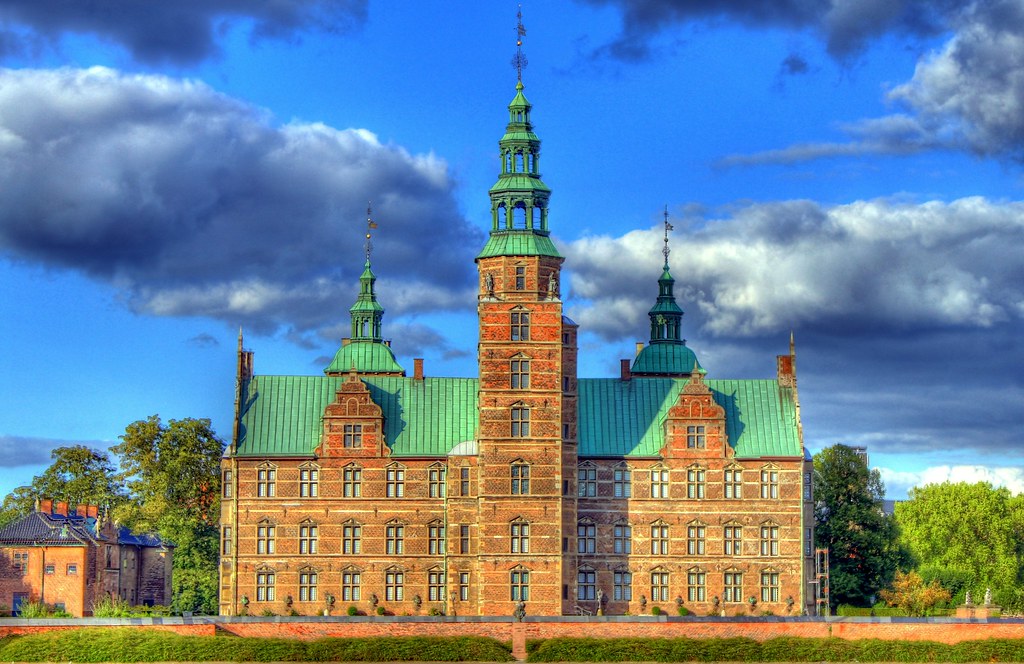Rosenborg might be the most recognizable of all Denmark castles. Surrounded by the blossoming pink of the botanical gardens across the street, the Rosenborg Castle is one of Copenhagen's top tourist attractions. The ornate ballrooms and lavish halls constructed in 1606 as the summer house of Danish King Christian IV, the castle has now been transformed into an overflowing museum which houses cultural treasures from the royal jewels to perfectly preserved beer glasses and baby shoes. Nothing belonging to the royal family seems to have gone unnoticed here, and every item is lovingly preserved for posterity.
Though Rosenborg Castle was intended only as a summer residence for the royal family, Christian IV ended up living and dying there, as did his successors for the next one hundred years. And it'll be no surprise why as you wander through his former chambers – the castle strikes a surprising combination of opulence and hominess. Though crammed full of artifacts, the interior still seems a bit sedated, as if it was embarrassed by all the riches contained within. Even the red-brick exterior (though designed in trademark Renaissance style) suggests a quaintness that is absent from most European castles.
With a facade that hasn't changed since 1633, the Rosenborg is the greatest and purest Renaissance structure in Denmark, and has survived both fire and war. A royal hermitage set in the King's Garden in the heart of Copenhagen, Rosenborg Castle features 400 years of splendor, royal art treasures and the Crown Jewels and Royal Regalia. Rosenborg Castle was built by one of the most famous Scandinavian kings, Christian IV, in the early 17th century. Today the castle, which is called Rosenborg Slot in Danish, is open to the public as a museum and houses the country's Royal Collections. The park that surrounds the castle, Kings Gardens, is a popular destination for the people of Copenhagen to relax or play.
It is not the largest of Denmark castles (that title goes to Amalienborg), but certainly the busiest, both in terms of visitors and things to see. It's place in the history of Denmark is unmistakable, and millions of tourists per year get a first hand glimpse of the wealth of the Danish monarchy. The museum's premiere highlights include the crown jewels, the Danish crown regalia, intricate coronation chairs, sweeping family portraits, and a pearl-studded coronation saddle. Three silver lions guard the vast aristocratic riches of the Knight's Hall, perhaps the most fascinating of the sections of the Rosenborg. And even if the adjacent treasury has more contained between its walls than a large percentage of total museums - it is the peripheral artifacts, such as the ancient beer glasses, that infuse the Rosenborg Castle with charm and character.
Denmark Map
Many of the finest Denmark castles are spread throughout the countryside, but this one is perfectly located right in the middle of Copenhagen. And since the capital city is eminently walkable, Rosenborg Castle is an easy addition to any Copenhagen tour, located not far from other popular attractions like Amalienhaven and the Kastellet. The King's Gardens, which surround the castle, are the oldest royal gardens in Denmark, and remain a popular meeting place for both tourists and locals alike, especially in the warm summer months.
Rosenborg might be the most recognizable of all Denmark castles. Texas holdem no sign up. Surrounded by the blossoming pink of the botanical gardens across the street, the Rosenborg Castle is one of Copenhagen's top tourist attractions. The ornate ballrooms and lavish halls constructed in 1606 as the summer house of Danish King Christian IV, the castle has now been transformed into an overflowing museum which houses cultural treasures from the royal jewels to perfectly preserved beer glasses and baby shoes. Nothing belonging to the royal family seems to have gone unnoticed here, and every item is lovingly preserved for posterity.
Though Rosenborg Castle was intended only as a summer residence for the royal family, Christian IV ended up living and dying there, as did his successors for the next one hundred years. And it'll be no surprise why as you wander through his former chambers – the castle strikes a surprising combination of opulence and hominess. Though crammed full of artifacts, the interior still seems a bit sedated, as if it was embarrassed by all the riches contained within. Even the red-brick exterior (though designed in trademark Renaissance style) suggests a quaintness that is absent from most European castles.
It is not the largest of Denmark castles (that title goes to Amalienborg), but certainly the busiest, both in terms of visitors and things to see. It's place in the history of Denmark is unmistakable, and millions of tourists per year get a first hand glimpse of the wealth of the Danish monarchy. The museum's premiere highlights include the crown jewels, the Danish crown regalia, intricate coronation chairs, sweeping family portraits, and a pearl-studded coronation saddle. Three silver lions guard the vast aristocratic riches of the Knight's Hall, perhaps the most fascinating of the sections of the Rosenborg. And even if the adjacent treasury has more contained between its walls than a large percentage of total museums - it is the peripheral artifacts, such as the ancient beer glasses, that infuse the Rosenborg Castle with charm and character.

Denmark Map

Denmark Map
Many of the finest Denmark castles are spread throughout the countryside, but this one is perfectly located right in the middle of Copenhagen. And since the capital city is eminently walkable, Rosenborg Castle is an easy addition to any Copenhagen tour, located not far from other popular attractions like Amalienhaven and the Kastellet. The King's Gardens, which surround the castle, are the oldest royal gardens in Denmark, and remain a popular meeting place for both tourists and locals alike, especially in the warm summer months.